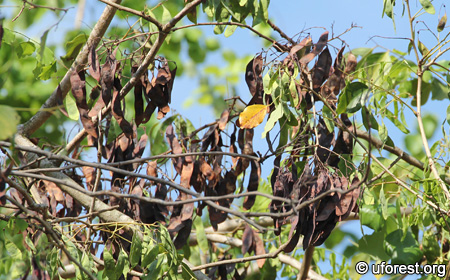Dalbergia latifolia Roxb.
| Etymology | Genus | After the brothers Nicholas and Carl Gustav Dahlberg, who are Swedish botanists |
|---|---|---|
| Species | Having wide leaves | |
| Family | Fabaceae | |
| Synonyms | Amerimnon latifolium (Roxb.) Kuntze, Dalbergia emarginata Roxb. | |
| Common Names | Indian Rosewood, Bombay Blackwood, Indonesian Rosewood, Malabar Rosewood | |
| Status | Exotic: Cultivated Only | |
| Form | Tree | |
| Native Distribution | Nepal to India, and Java | |
Diagnostics:
Dalbergia latifolia is a graceful tree with spreading but open crown; much like its congener, Dalbergia oliveri. They can be easily differentiated as D. latifolia's leaflets are almost circular and very wavy at its margins, while D. oliveri is oval and non-wavy.
Interesting Facts:
The Indian Rosewood is listed as Vulnerable by IUCN Redlist because of overexploitation of its wood (Asian Regional Workshop, 1998). The high-quality timber is used for making furnitures, wood for decorative and construction work, musical instruments, handles of umbrellas and hammers, etc. (Lemmens, 2008).
Form of the Indian Rosewood; having a widespreading but open crown.

The leaflets are circular and wavy.

Flowers are numerous and white.

The legumes are flatten and contains one to four seeds.
References
Asian Regional Workshop (Conservation & Sustainable Management of Trees, Viet Nam, August 1996) 1998. Dalbergia latifolia. IUCN Red List of Threatened Species. Version 2012.2. International Union for Conservation of Nature. http://www.iucnredlist.org. Accessed on 24-Mar-2013.Lemmens RHMJ. (2008) Dalbergia latifolia Roxb. In: Louppe D, AA Oteng-Amoako & M Brink. (Eds.) PROTA (Plant Resources of Tropical Africa / Ressources végétales de l’Afrique), Wageningen, Netherlands. http://www.prota4u.org. Accessed 24 -Mar-2013.
Author: Siyang
Posted: 2013-03-24 / Modified: 2019-08-27
Google Ads